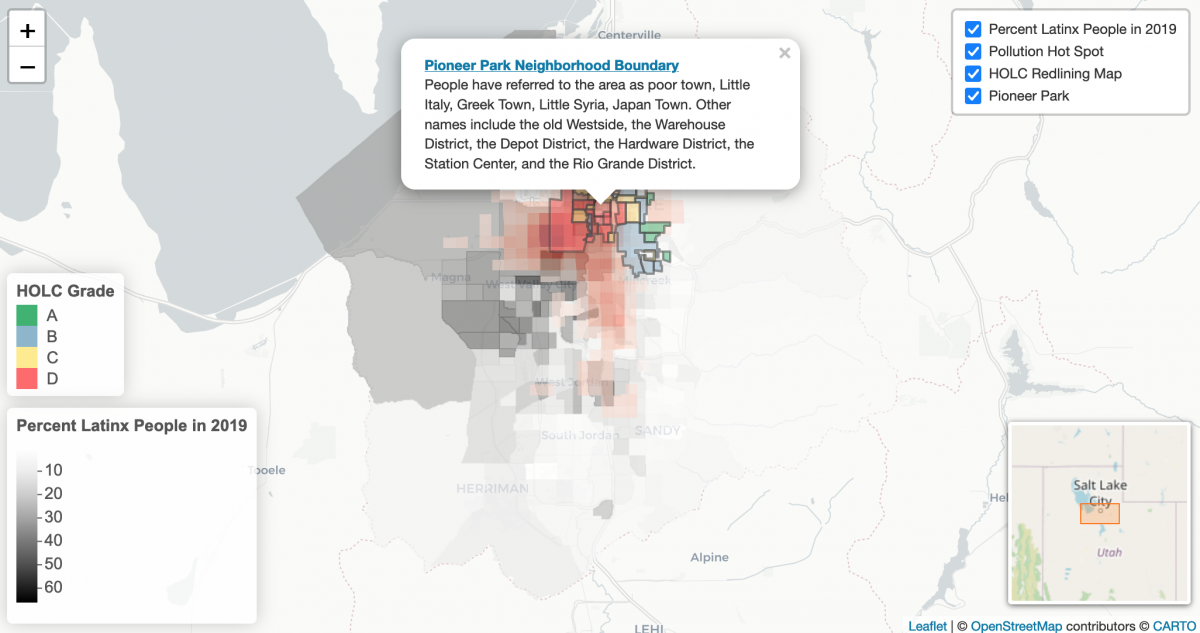Salt Lake West Side Stories: Post Thirty-five
By Dr. Mariya Shcheglovitova, Emma Jones, Catherine Aviles, and Brad Westwood
Unlike other areas that received a grade (A to D) from the Home Owners’ Loan Corporation (a federal corporation created during the Great Depression), the Pioneer Park neighborhood was designated “Industrial,” implying it was nonresidential. However, woven between the railroad yards and spurs, warehouses and manufacturing plants, were dozens of upstairs flats, small apartment blocks, and housing accessible only through alleyways. In this setting, waves of immigrants lived, including, by the mid-twentieth century, a thriving Mexican American community.
As the United States (U.S.) gradually recovered from the Great Depression’s social and economic devastation, President Franklin D. Roosevelt and the federal government created a series of programs, regulations, and reformations to help stabilize and rebuild the nation’s economy. The Home Owners’ Loan Corporation, also known as the HOLC, was created with the purpose of helping Americans refinance home mortgages and prevent foreclosures (Gross, 2017). Sadly, the prevailing racial prejudices of the day were embedded in this program’s policies. The application of the HOLC’s discriminatory lending guidelines were no different in Salt Lake City (SLC) than any other American city. Across the U.S., redlining and its legacies have left lasting environmental and financial impacts on communities of color.
Between 1935 and 1940, the HOLC was aided by local lenders and real estate appraisers in producing guidelines and maps identifying mortgage lending “risk” for cities with a population above 40,000. These guidelines were displayed on “redlining” maps that classified cities into zones. Areas with the highest grade, “A,” were displayed in green to indicate the lowest risk for mortgage lenders. Areas with the lowest grade, “D,” were classified as “Hazardous” and displayed in red, which earned them the name “redlined.”
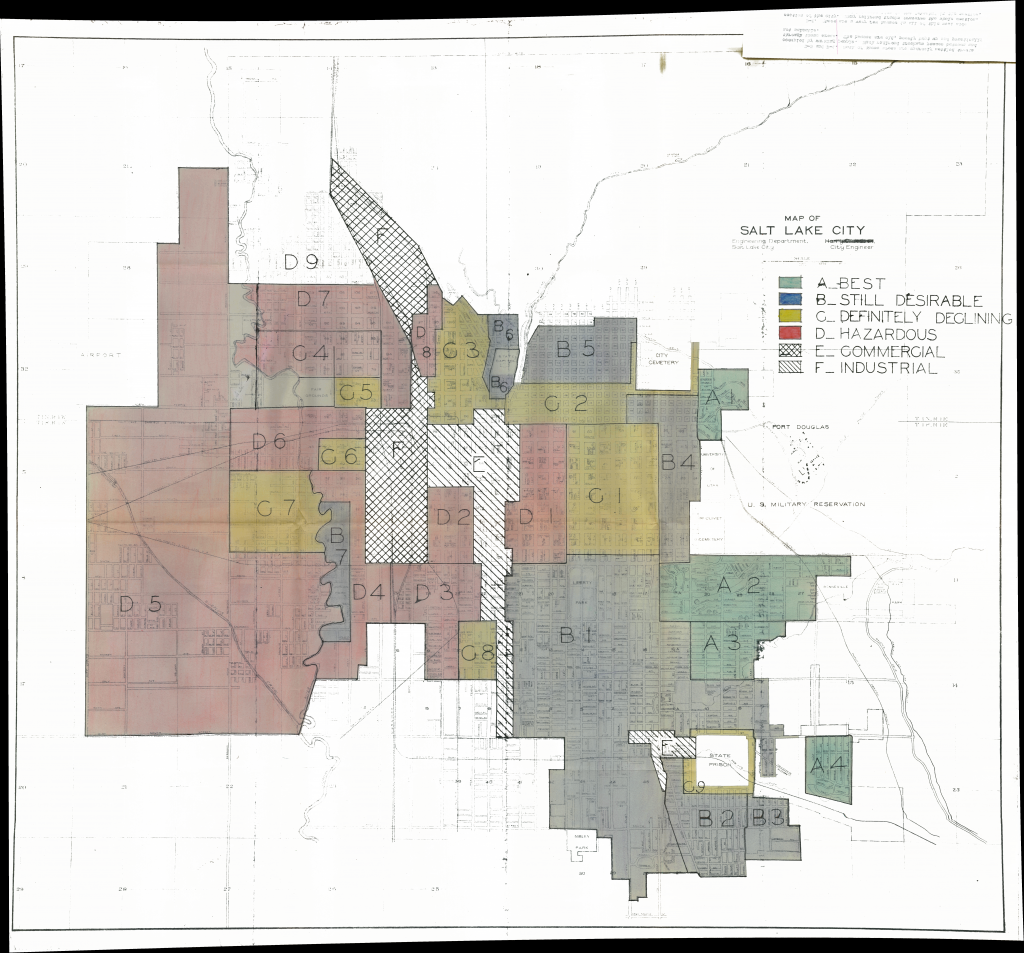
Digitized redlining maps and HOLC area descriptions are made available through the Mapping Inequality project (Mapping Inequality (richmond.edu)). This project is the result of a collaboration between the University of Richmond’s Digital Scholarship Lab led by Robert K. Nelson, a team led by History Professor La Dale Winlin at Virginia Tech, and a team led by Professor Richard Marciano at the University of Maryland Digital Curation Innovation Center.
.
The HOLC assigned mortgage risk grades based on information appraisers identified about housing conditions, cost, and neighborhood residents. This information included the age and condition of housing, sale and rent value, and the racial and ethnic identity and class of neighborhood residents. In SLC and other U.S. cities, HOLC guidelines openly insisted that the presence of African Americans and other people of color, as well as immigrants and working-class whites, compromised home values and led to higher-risk mortgages. These guidelines led lenders to deny mortgages to African Americans, Native Americans, and other people of color, while white, wealthy community members would qualify for and benefit from housing loans and security.
“The term ‘redlining’ is used to describe the practice of limiting access to financial services to people in particular geographic areas and is often associated with the racial composition of a neighborhood.“
The term “redlining” is used to describe the practice of limiting access to financial services to people in particular geographic areas and is often associated with the racial composition of a neighborhood. Neighborhoods where the majority of residents were Black, Brown, or immigrants (what today is included in the acronym BIPOC or “Black, Indigenous and People of Color”), were disproportionately redlined. This made it more difficult for people belonging to these communities to secure home loans or buy and renovate homes, especially outside of redlined areas. Housing segregation practices, like redlining, prevented communities of color from achieving what many white people were able to do, that is, create individual or multigenerational wealth through homeownership, home improvement, and home equity loans (Coates, 2014).
The HOLC produced redlining maps for two Utah cities, Ogden and Salt Lake City. In the latter, areas with a higher proportion of residents of color and pollution densities, such as industrial sites associated with the railroad industry, were classified as “Hazardous” or “Definitely Declining” (HOLC grades D and C), while majority-white neighborhoods located at a greater distance from industry were classified as “Still Desirable” or “Best” (HOLC grades B and A). Unlike areas that received a grade by the HOLC, the Pioneer Park neighborhood fell within an area designated as “Industrial,” suggesting that HOLC appraisers didn’t view this neighborhood as generally inhabitable. However, this “Industrial” classification contradicts historic accounts of a thriving Mexican American community living in Pioneer Park (Allen, 1947).
Professor of History, Ocean Howell, describes residential areas that were not given a grade by the HOLC as “no-lined.” In his book, Making the Mission: Planning and Ethnicity in San Francisco, detailing the history of the Mission neighborhood in San Francisco, he writes that people living in “no-lined areas would have a difficult time securing a mortgage from anyone, on any terms” (Howell, 2015). In addition to perpetuating the housing inequality promoted through redlining, no-lining marked areas as targets for industrial and commercial uses (Howell, 2015). Salt Lake City’s “no-lined” Pioneer Park Neighborhood, the city’s original international neighborhood and industrial area, is today part of an extended industrial corridor that loosely follows the Jordan River, the railroad tracks, the Interstate Freeways, with radiating and growing industrial areas within South Salt Lake, Salt Lake City, Glendale, North Salt Lake and beyond. Despite the intensification of industrial use, these areas continue to be where the majority of Salt Lake City’s immigrants and communities of color live.
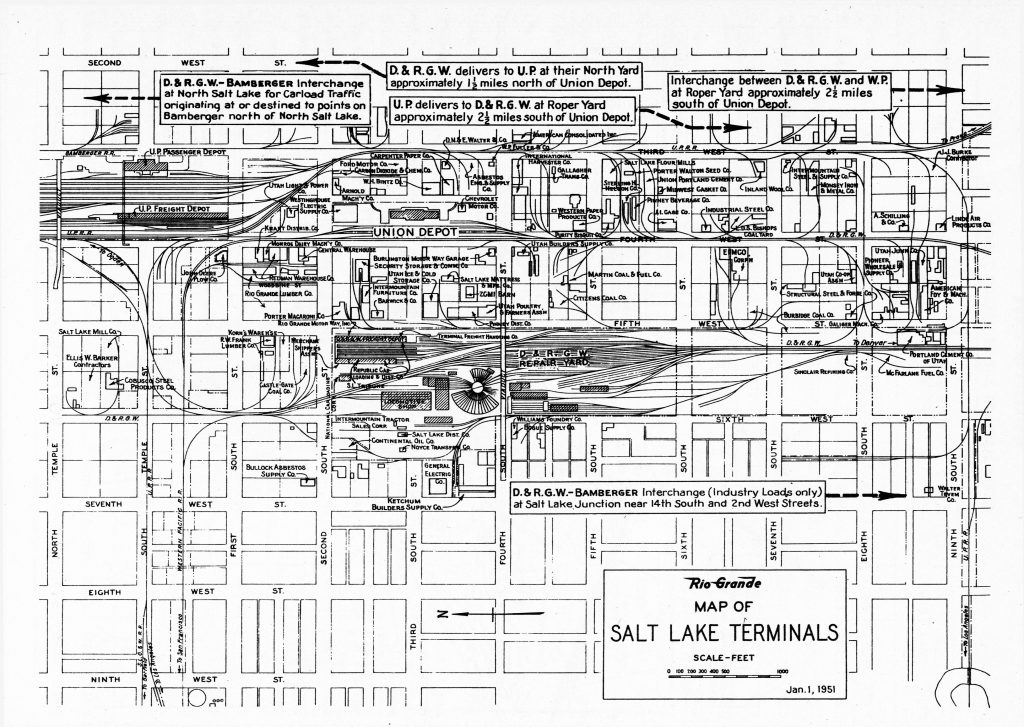
In 1968, redlining in mortgage lending was made illegal by the Fair Housing Act (HUD) but it still persists in less explicit ways today. For communities of color, housing choice remains largely constrained to polluted areas. Environmental Justice scholar Laura Pulido has termed the higher exposure of BIPOC communities to environmental pollution compared to white communities “environmental racism.”
“Their analysis revealed a clustered toxic site hotspot in downtown and in Salt Lake City’s west side that follows the I-15 corridor.“
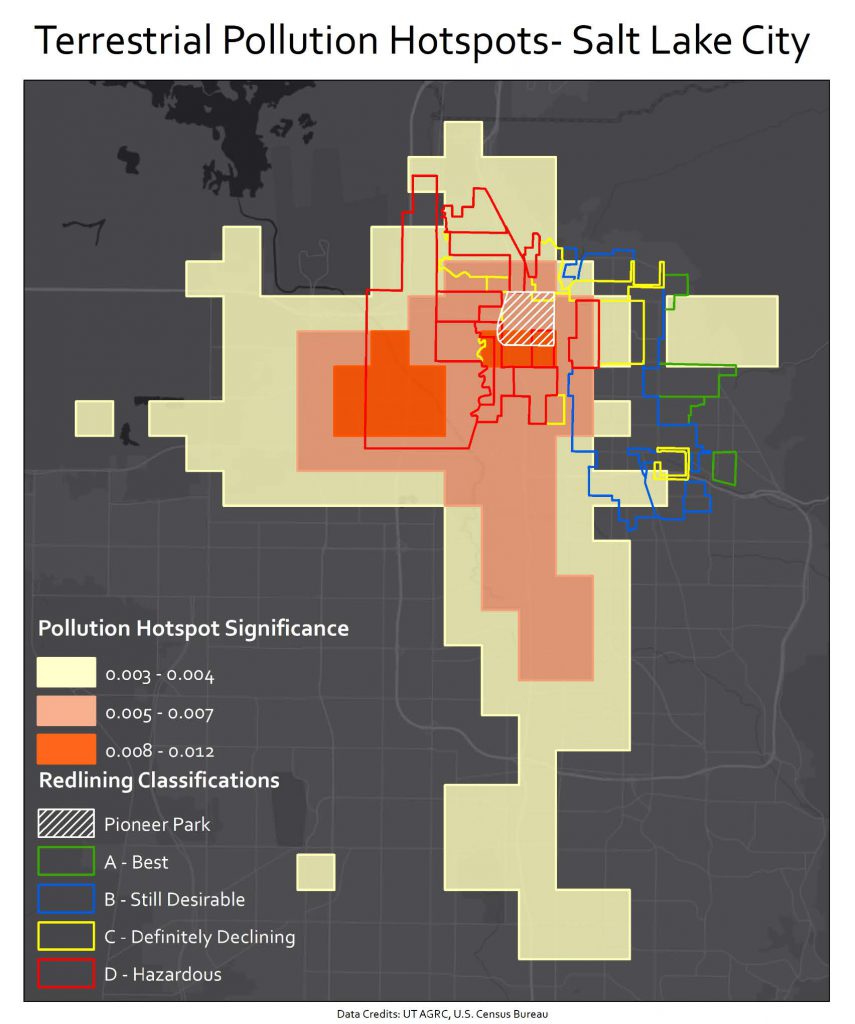
Utah State University Geography Professor Mariya Shcheglovitova and undergraduate honors student Emma Jones conducted an analysis of terrestrial pollution hotspots in Salt Lake City. Polluted sites used in the study include hazardous waste and used oil facilities, solid waste facilities, superfund sites, brownfield sites, and environmental remediation sites (UT AGRC). Their analysis revealed a clustered toxic hotspot in downtown and in Salt Lake City’s westside that follows the I-15 corridor. The most significant concentration of toxic sites was observed in West Salt Lake, particularly in the Glendale Neighborhood. Glendale, which is 7 miles southwest of Pioneer Park, contains the 2010 census tracts with the most Latinx residents living in Salt Lake City.
This is the legacy of the history described in prior Salt Lake West Side Stories posts. These spatial patterns also conform to the redlined “Hazardous” and “no-lined” industrial areas of Salt Lake City. Conversely, areas designated as “Best” or “Still Desirable” by the HOLC have minimal overlap with significant pollution hotspots, which corresponds with historic accounts of fewer polluting industries located in the predominantly white, Jesus Christ of Latter-day Saints communities in east Salt Lake City, who historically had and still have more access to personal banking and mortgages and to municipal expenditure and infrastructure.
.
Studying environmental pollution in the context of historic practices like “redlining” provides a lens into how housing segregation along racial and economic divides and the geographic confinement of minoritized communities to industrial areas weaves environmental racism deep into the fabric of cities. This research suggests that cities like Salt Lake City with growing communities of color must consider how historical spatial patterns of segregation will not only perpetuate long-held practices of housing discrimination but also perpetuate exposure to environmental harms.
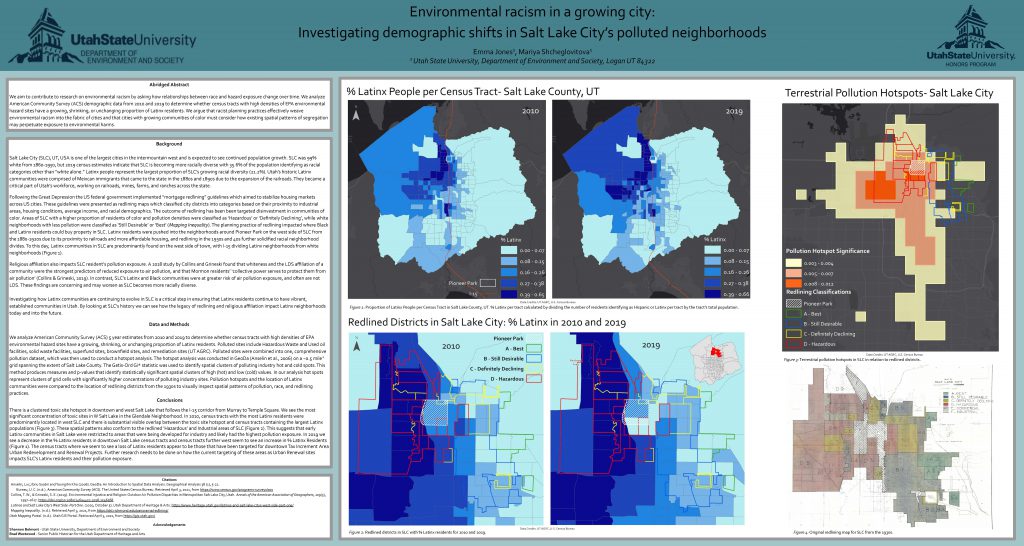
Thank you for reading this post about Redlining, Housing Segregation and Environmental Pollution. We hope that you join us for the next Salt Lake West Side Stories post. Click here to return to the complete list of posts.
Related Activities: You can read more about the research highlighted in this post in Emma Jones’ Honors Thesis: Jones, E. N. (2021). “Environmental Racism in a Growing City: Investigating Demographic Shifts in Salt Lake City’s Polluted Neighborhoods.” https://digitalcommons.usu.edu/cgi/viewcontent.cgi?article=1723&context=honors.
Contributors: Utah State University Geography Professor Mariya Shcheglovitova and undergraduate honors student Emma Jones are responsible for this research and for the post’s content. Utah Department of Culture & Community Engagement intern Catherine Aviles drafted and edited the post aided by Shcheglovitova, Jones and Westwood.
This post was researched and written by Dr. Mariya Shcheglovitova, Emma Jones, Catherine Aviles, and Brad Westwood, with a whole lot of help from friends. Thanks to our sound engineer and recording engineer Jason T. Powers, and to his supervisor Lisa Nelson, both at the Utah State Library’s Reading for the Blind program. Thanks also to yours truly, David Toranto, for narrating this post.
Selected Readings:
Allen, Joseph E. “A Sociological Study of Mexican Assimilation in Salt Lake City.” Master’s Thesis, University of Utah, Salt Lake City, 1947.
Coates, Ta-Nehisi. “The Case for Reparations,” The Atlantic, June 2014.
Faber, Jacob W. “We built this: Consequences of New Deal Era Intervention in America’s Racial Geography.” American Sociological Review, 85(5), 739-775.
U.S. Department of Housing and Urban Development. History of Fair Housing – HUD | HUD.gov / U.S. Department of Housing and Urban Development (HUD). Accessed April 4, 2023.
Do you have a question or comment? Write us at “ask a historian” – askahistorian@utah.gov

